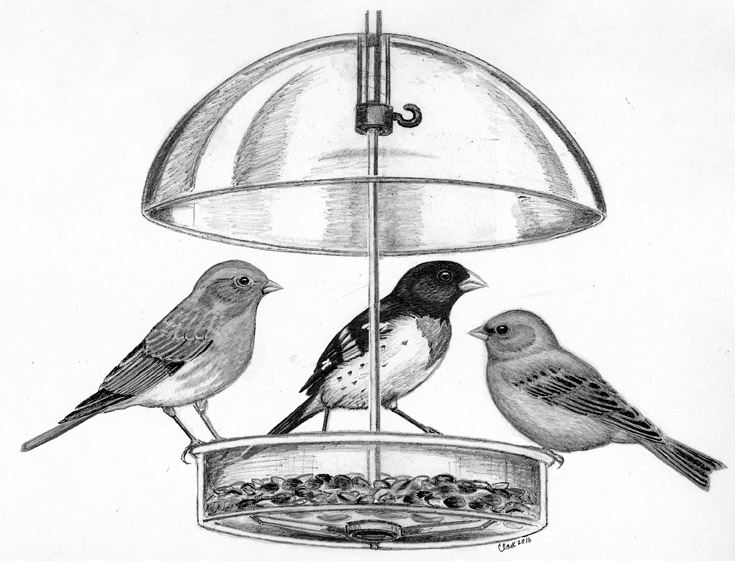
Dear Bird Folks,
I’ve been told that we should take our birdfeeders down in May. With the improving weather, the birds now have plenty of natural food to eat and therefore, don’t need our handouts. Do you agree with this?
– Eric, Barnstable, MA
No, no, no, Eric,
Of course I don’t agree with that. Telling a bird shop owner that people should stop feeding birds this time of year is like telling a deli not to sell hot dogs on the Fourth of July or telling a bartender not to serve alcohol on St. Patrick’s Day. It’s a bad business plan. May is when the birds have finally returned from the south, and now you want me to tell people to stop feeding them? I don’t think so.
I’ve said this before, but basically we feed birds for our own entertainment. Oh sure, birds might benefit from our feeders, but we are the ones who benefit the most. Feeder birds keep us company. They are like having pets (only without those astronomical vet bills or having a couch covered in fur). To feed or not to feed birds is really up to you. If in May (or anytime) you don’t feel like seeing birds on your feeders, take them in the house (the feeders, not the birds) and put them away until you want to see them again (the birds, not the feeders). The birds will find alternative food sources until your feeding-mood improves. If you are only going to feed birds for one month of the year, however, it should be May. Why May? Many birds only stop here during spring migration. This is when we have a good chance to see birds that we might not see at any other times. And which birds are those, you ask? Read on.
No avian event sends folks running for their cameras faster than a visit from a Rose-breasted Grosbeak. These birds feature giant beaks, black heads and white bellies, plus blood-red breast spots that make them look like victims in Murder She Wrote. Just about anyone who sees a Rose-breasted Grosbeak says the same thing: “I haven’t seen one of them since I was a kid.” In reality, rose-breasteds are fairly common breeders in Massachusetts, but are not seen so much on the Cape…except in May…if you have a feeder out.
Contrary to what many people think, Purple Finches are infrequent visitors to these parts. Folks often confuse them with the ubiquitous and similar-looking House Finches. Anyone who would like to see an actual Purple Finch should pay close attention to the finches on their feeders right now. Even though Purple Finches are uncommon, they are less uncommon in May. (“Less uncommon”? Sure, why not?) I actually had a Purple Finch on my feeder just last week. I called the local bird store to tell the guy, but it was closed. (Doesn’t that guy ever work?)
The Indigo Bunting is another unmistakable spring arrival. Covered in more blue than even a bluebird, Indigo Buntings spend the winter in the tropics and return to Cape Cod in – you guessed it – May. Throughout much of their range these buntings are in decline, but as is the case with a lot of things, the Cape is bucking this trend. The latest breeding census indicates that our population of Indigo Buntings is actually growing. Still, I don’t get a lot of reports of buntings eating from feeders, except in May, when they come and eat thistle and millet. Millet? Yes, there’s actually a bird that eats millet. I always knew there had to be at least one.
White-crowned Sparrows are in a hurry to get to their High Arctic breeding grounds, but that doesn’t mean they won’t stop and grab a quick snack from under our feeders on their way north. Every May one of these inconspicuous birds reliably shows up in my yard and I’m always glad to see it. White-crowned Sparrows may not be as exciting to look at as a Rose-breasted Grosbeak or an Indigo Bunting, but you have to appreciate a small bird that can fly to the Arctic on basically a seed diet. You also have to appreciate a sparrow that has the decency to have an obvious field mark, which is a bright white (and black) head-crown. This makes it possible for even novices to identify it. Very few sparrows are that considerate.
Back in May of 1983, when I first came up with the idea to open a bird shop, I thought I was opening at the wrong time of year. After all, everybody knows fall is the time to feed birds. I could not have been more wronger. When May temperatures are below normal, like this year, insect hatchings are delayed, thus birds must scrounge to find food. Right now customers tell me that their feeders are busier than ever. In fact, this past week we’ve sold over ten tons of birdseed and could have sold more, but we ran out. Really. However, all good things have to come to an end and that happens in June. When the bugs finally do hatch out, most birds will switch to an insect diet. They will visit feeders less often, my seed sales will drop, and I’ll have to move back in with my parents. I hate June (and so do my parents).
As I said way back at the beginning of this column, Eric, you should feed birds whenever you want to see them. But if you are only going to feed them one month of the year, pick May. Of course, you could ignore what I’ve just said and take your feeders down regardless. But if you do that, you should know that every time someone in the world takes down a birdfeeder, I die a little bit. I hope you can live with that.